John Hurrell – 21 January, 2017
Grisly though their origins are, these undulating forms with their flowing arabesque edges are perversely pleasurable to examine and think about. Being deceptively complicated, they are beautiful and disturbing; sexy and ghoulish, here presenting a wit about space and the corporeal. There is a synthesis that occurs between a boxlike container where a cadaver could be enclosed, hidden, or frozen - and a ‘flat' piece of morgue furniture where the body is opened up and examined.
Auckland
Rachel Whiteread
Untitled (Pair), 1999
On loan from Erika and Robin Congreve
13 November, 2013 - 30 June, 2017
Up on the rooftop terrace, this two part cast sculpture by British artist Rachel Whiteread has painted bronze elements that look like minimalist tombs; they appear to be whiteware freezers, or pale sarcophagi designed by Donald Judd. They have migrated away from the Albert Park vista of the top photograph you see here, shifting around the corner to be closer to the Art Gallery clock tower and the Chartwell Gallery entrance - as indicated by the other images. Their installation setting is more urban and architectural now. They make greater sense within a more mausoleum-like ambience.
The gallery’s positioning of these two parts (their interaction) is important too, accentuating a vertical slab of empty space separating the two that becomes a kind of negative stem that supports an unseen canopy spread over the two modulated tops.
At a first glance you might think the two white ‘tombs’ are identical, but you soon realise they are not. Their top surfaces are subtly concave and convex at different ends, and slope in opposite directions. There is a relationship between the two undulating planes: one hefty unit could be flipped over to lock tightly into the other below, while inverted and balanced on top.
One of them is a replica of a mortuary table and the other is cast off it. The table one is nearest the glass safety barrier at the edge of the roof. It has a convex end that is slightly raised from a table designed so that during autopsies bodily fluids drain down to the other (concave) rounded tip which is like a curved tray. There are also channelling indentations around the sides to help extract sluicing liquids or bits of the cut-into corpse. With their round ends the parallel bulky forms also look like toppled lingams, squat snub-nosed bullets, elongated breasts or hunched shoulders.
Grisly though their origins are, these undulating forms with their flowing arabesque edges are perversely pleasurable to examine and think about. Being deceptively complicated, they are beautiful and disturbing; sexy and ghoulish, here presenting a wit about space and the corporeal. There is a synthesis that occurs between a boxlike container where a cadaver could be enclosed, hidden, or frozen, and - referenced at its top - a ‘flat’ piece of morgue furniture where the body is opened up and examined, and which initiates the work’s production.
Chilling, enigmatic and profound, to see this Whiteread in Auckland is quite a thrill. Hats off to the Congreves for making it available.
John Hurrell
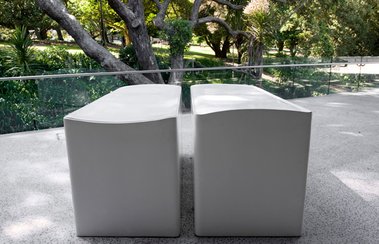
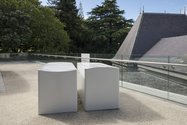
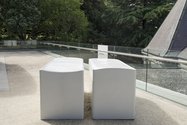
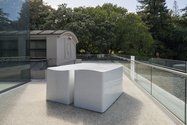
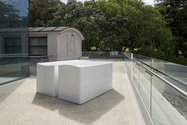
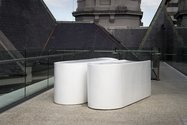
 Advertising in this column
Advertising in this column Two Rooms presents a program of residencies and projects
Two Rooms presents a program of residencies and projects



This Discussion has 0 comments.
Comment
Participate
Register to Participate.
Sign in
Sign in to an existing account.